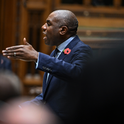There have been many efforts to explain why Indians vote as they do: package tours through India's castes, religions and languages seek to explain the pattern of democratic politics. But the more basic question-why do Indians vote at all?-is rarely asked. It is worth a moment's reflection, as an electorate of 590m goes to the polls over the next few weeks (the country's hottest) for the 11th general election since 1947.
There are many disincentives for the individual voter. Parliamentary constituencies are huge-there are only 545 seats for a population of 900m. (While the electorate has grown from 173m in 1952 to 590m in 1996, the Lok Sabha, the Indian lower house, has expanded by only 50 seats.) With barely half the population literate, most voters cannot even read the names of the parties, let alone their manifestos: parties are identified on ballot papers by graphic symbols, not names. In a society which has always consigned politics to a marginal if spectacular role, elected politicians remain remote, holding court at their colonial bungalows in Delhi. Most national parties, the Communists apart, do not represent clear social groups, and voters have little reason to show long term party loyalty. Voting can even be fraught with physical danger, and corruption is often a more effective way of getting one's interests represented.
Yet Indians do vote. Indeed, the most indisputable fact about Indian politics is that participation rates are rising. Electoral turnouts have averaged around 60 per cent in the eight general elections since 1962. While the institutions of political representation seem to be crumbling, elections have gained a new vitality.
Most accounts have portrayed Indian democracy as either a passion play or a bazaar. On the latter view elections function in India-as in the west-like a market: traditional hierarchies have simply grafted themselves on to democratic politics. Politicians emerge as brokers and "fixers," ideologically plastic entrepreneurs who bargain with each other and with voters, buying and selling votes in return for goods and services. The Congress party, winner of all but two of India's 11 general elections, was long seen as the most skilled in this task, functioning not as an ideological party but as a distributional machine.
In contrast to the bazaar theory, some argue that Indian elections make no difference. They are just a ceremony of legitimacy, a symbolic rite in a ritual-ridden society. The real power struggles occur elsewhere; democracy is merely a stage set, a toy in the hands of economic interests or religious passions.
India's electoral politics do not fit any of these theories of liberal democratic politics. Contrary to expectations, India's traditional social divisions have not translated easily into the party political system. (What is striking about the Hindu nationalist Bharatiya Janata party (BJP), is not its current level of support, but the fact that it has taken so long to gain political weight: until 1991, when it won about 25 per cent of the vote, its support on the national level was well below 10 per cent.) The dominance of the Congress party was never based on a particular caste, religion or class; no party based on such cleavages has ever held national power. But since 1971, the electorate has become more volatile, delivering temporary landslide majorities which do not translate into stable governments. The counterpart of this weak electoral allegiance has been the phenomenon of political "defections" from parties.
There is no reliable explanation for the most decisive development in India's politics today: greater participation, and greater competition. In the 1991 general election, there were almost 9,000 contesting candidates (the deposit needed to stand is 500 rupees, less than £10, and it is half that sum if you belong to one of the "scheduled" castes or tribes-in whose favour the government positively discriminates), while in the state legislative elections of the past couple of years, more than 40,000 candidates fought over fewer than 3,000 seats. Voters, as well as politicians, increasingly come from new social groups, and the "backward" castes are becoming more politicised. Last year, the state of Uttar Pradesh, which has provided the country with seven of its ten prime ministers, was governed by Maya Wati, a "backward caste" woman. This would have been unthinkable ten years ago. Voters are voting for their own reasons-and we don't know what these are.
If the idea of democracy is working new and strange shapes on the Indian landscape, democracy as a principle of government and a set of institutions is in disarray. A swamp of examples exists to illustrate this, but it is also worth noting an important success: the question of political succession. One should not forget the parlour game of the 1960s-"After Nehru, who?"-as well as those who confidently forecast that the country could not be governed by someone without the appropriate genealogy. The fact is that at both state and national level, governments have changed peacefully as a result of elections. Three generations of the Nehru family did dominate the political scene between 1947 and 1991 (and even during the four years when they were not in government they effectively undermined it). But if three of India's prime ministers were members of the Nehru family, there were also seven who were not-although PV Narasimha Rao, the current prime minister, will be the first who isn't a member of the family to complete a full term.
That is an achievement in itself, and it shows that the Congress party is learning to live without the Family. As a political party and organisation, however, it is evidently in long term decline. In the 1993-95 state elections, it lost its "natural" states (such as Maharashtra), and in Bihar, Karnataka, and most strikingly of all, in its historical homeland, the most populous state of Uttar Pradesh, it came third. It no longer commands any special loyalty among voters-even Muslims, on whom Congress could once rely.
Alongside the decline of the Congress, another important fact has been the rearrangement of the relationship between the national government-the so-called Centre-and the regional governments. The federal system, mistreated by the Centre over the past 25 years, is taking its revenge. In reaction to the centralising and plebiscitary politics of Congress governments, regional parties have emerged to produce a political landscape more differentiated than ever. Even the Hindi heartland of the north (the states of Uttar Pradesh, Bihar, Madhya Pradesh and Rajasthan, home of around 350m people) has broken up politically, with four different parties ruling in each of the four states.
The pulling away of the regions is taking place at a time of economic liberalisation, and this will make its effects more profound. Since independence, the Indian state has sought to fulfil its redistributive commitments not through taxation, but through "planning" (intervening to cross-subsidise and invest in underdeveloped regions). As the Centre sheds this role, regional governments have had to begin to fend for themselves: hence Bengal's Communist government inviting direct investment by promising a docile labour force. Meanwhile, foreign lending agencies have made it clear that they will give direct assistance to states which seem willing to undertake structural reforms.
The vitality of politics in the regions is matched by a vacuum at the Centre. There is no obvious party which can fill the political space at the national level; and the possibility of centrist politics, of the type associated with the old Congress, is increasingly difficult to sustain. Does this mean that the time has come for the Hindu nationalist BJP, with its exclusivist appeal and impressive level of party organisation? Probably not. Political success, and participation in government at the state level in Gujarat, Uttar Pradesh, Rajasthan and Maharashtra, have compromised the party, which is beginning to look remarkably like any other. It is still unable to make inroads into the great coastal belt stretching from Kerala in the west to Bengal in the east. It remains a regional party, although its homelands are India's most densely populated states.
The current election might be expected to serve as a verdict on the post-1991 policies of economic liberalisation. But the economy has been a non-issue. On the surface, the indicators are good: inflation is under 5 per cent, exports are growing, and savings and investment have risen. Foreign investment is also up, taking advantage of a low rupee and a cheap stockmarket. However, deficits remain difficult to control, and the government continues to borrow heavily. The liberalisation programme has been pushed through by increments rather than by shock therapy and all parties, even the Communists, are broadly agreed on its necessity. The policy came not from ideological conviction (it was imposed by the IMF), nor did it represent the interests of a specific social class.
Elections in India produce governments, but perhaps that is not their main significance. In a rebuff to Schumpeterian wisdom, Indian politics has not observed a smooth evolution from mass participation to a closed elite game, where voters are invited to choose the best bargain. The movement has been quite the reverse. The procedural politesse of the Nehruvian period has given way to a coarser, more vigorous participation. Democracy has not yet found the form it requires; but it is transforming society. Indians vote because they are able to do so, which is more than can be said for many other Asian countries.











